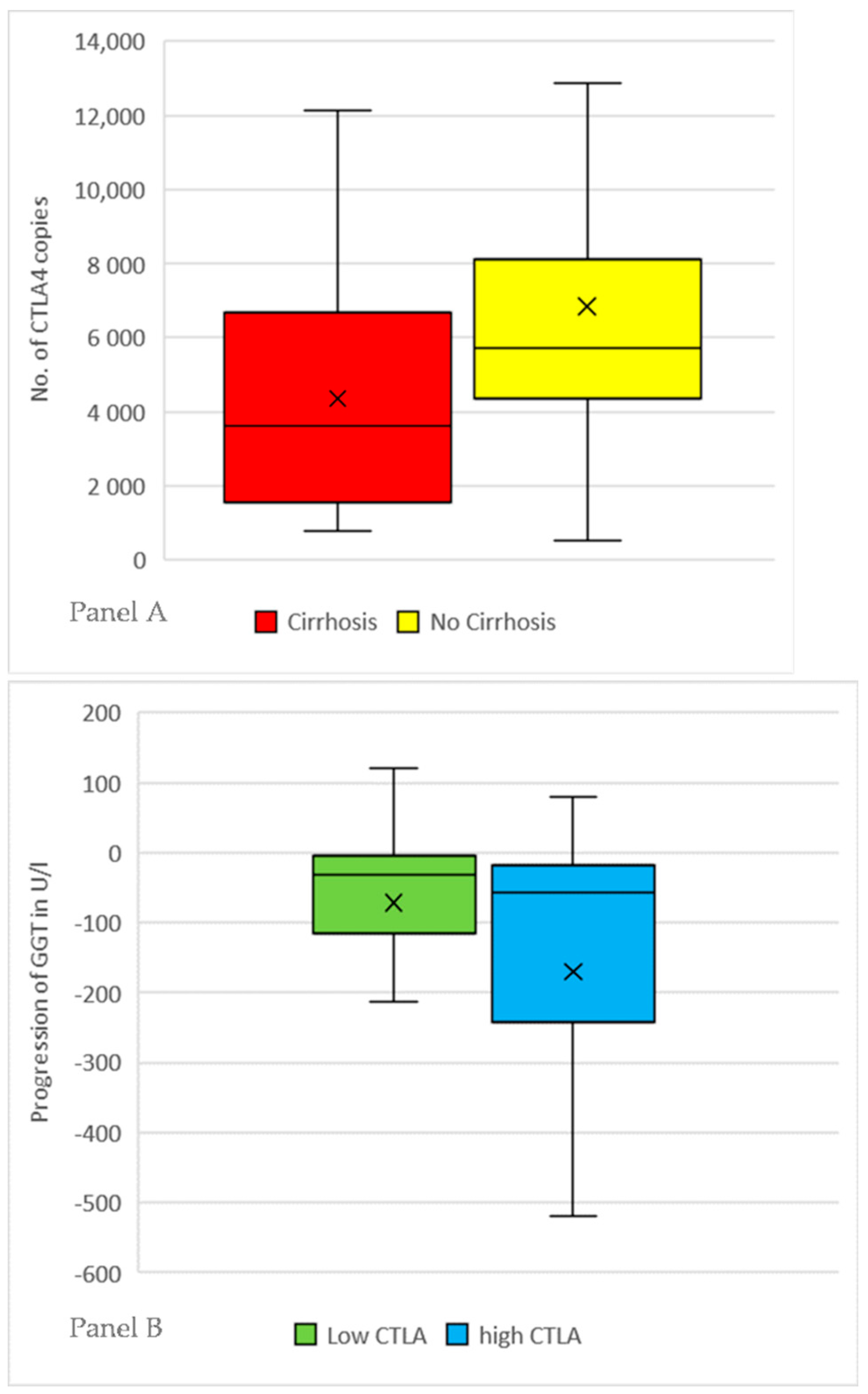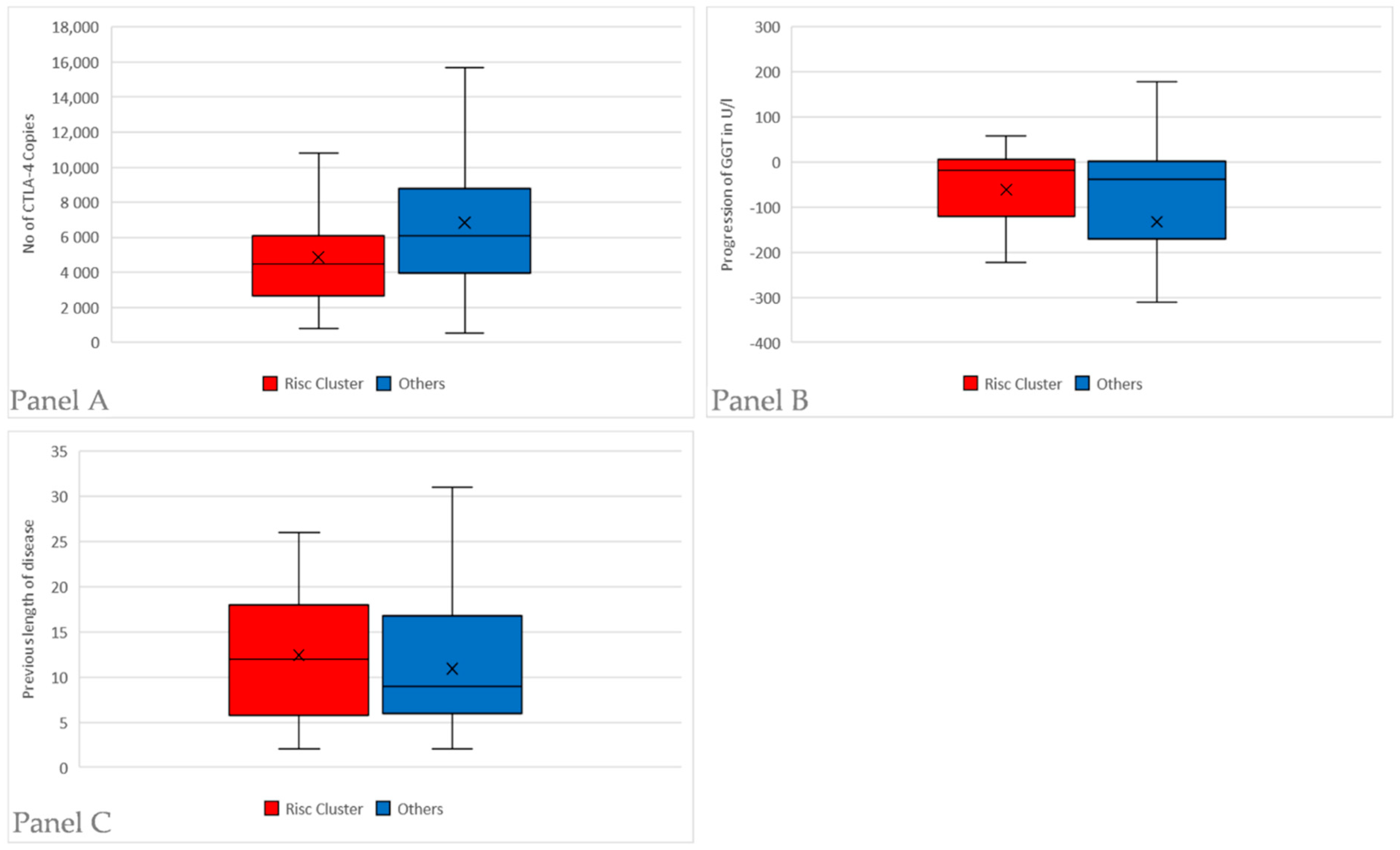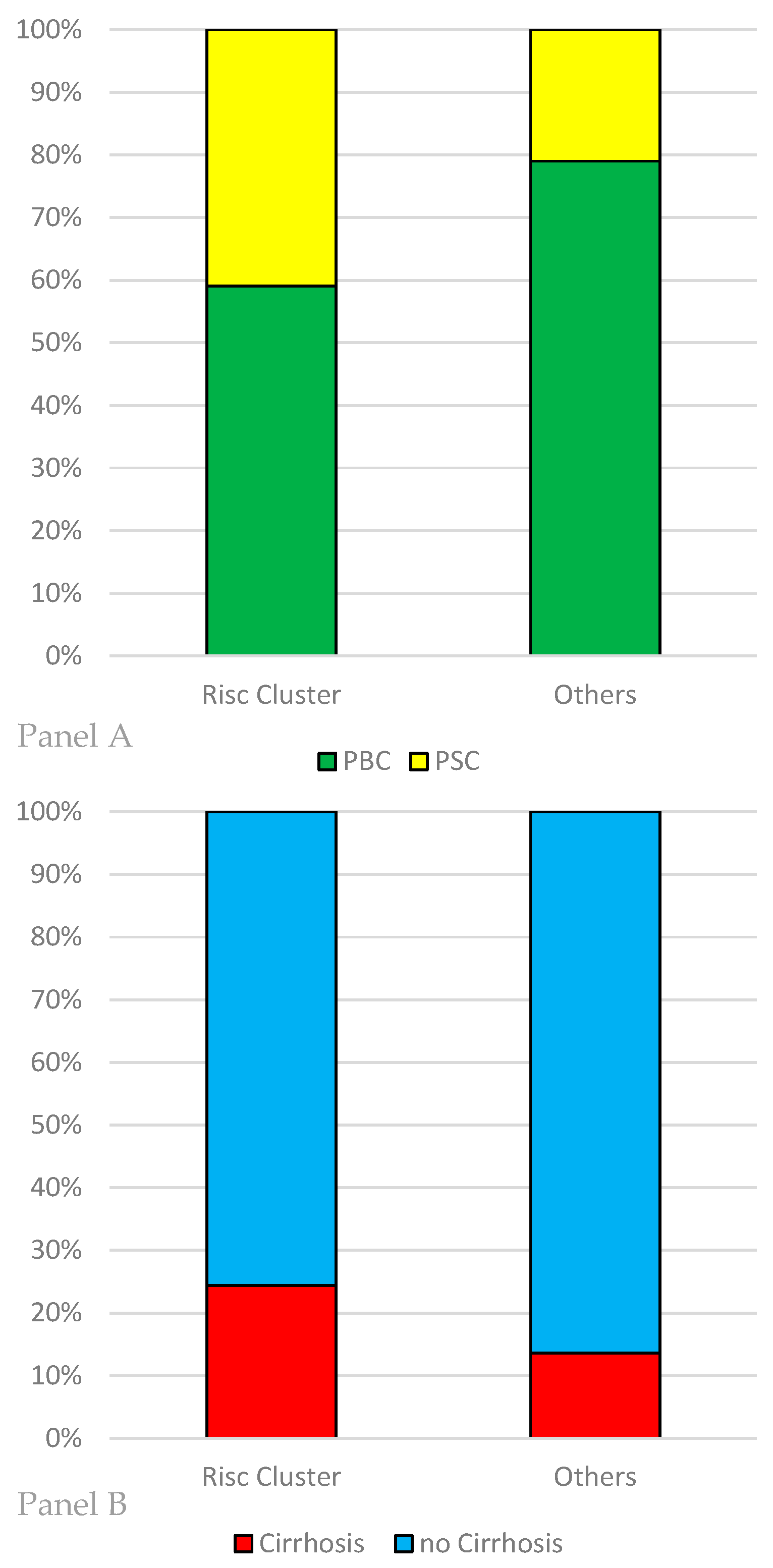CTLA-4 Expression Plays a Role in PSC and PBC Progression
Abstract
:1. Introduction
2. Material and Methods
2.1. Patients
2.2. DNA Extraction and Genotyping
2.3. Data Collection and Statistical Analysis
3. Results
3.1. Low Number of CTLA4 Copies Appears to Be Correlated with Cirrhosis and Aggravation of Liver and Cholestatic Enzymes in PBC Patients
3.2. Certain SNP-Haplotypes of CTLA4- and FOX-P3 Gene Are Correlated with a Lower Expression of CTLA4
4. Discussion
4.1. Lack of CTLA-4 as Inhibitory Marker Is Linked to a More Advanced Disease in PBC & PSC Patients
4.2. We Describe an Association of the CTLA4 SNP rs733618 and the FOXP3 SNP rs2280883 with PBC and PSC for the First Time
4.3. The Role of Epigenetic and Immunogenetic Features in PBC and PSC
5. Conclusions
Author Contributions
Funding
Conflicts of Interest
Abbreviations
| PBC | primary biliary cholangitis |
| PSC | primary sclerosing cholangitis |
| AMA | anti-mitochondrial antibodies |
| pANCA | perinuclear anti-neutrophil cytoplasmic antibodies |
| HLA | human leukocyte antigen |
| SNP | single nucleotide polymorphism |
| CTLA4 | Cytotoxic T-lymphocyte-associated Protein 4 |
| FOX P3 | Forkhead-Box-Protein P3 |
| ICOS | Inducible T-cell COStimulator |
| PCR | polymerase chain reaction |
| RFLP | restriction fragment length polymorphism |
| CI | confidence interval |
| AP | alkaline phosphatase |
| GGT | γ-glutamyl transferase |
| ALT | alanine transferase |
| INR | international normalized ratio |
References
- Beretta-Piccoli, B.T.; Mieli-Vergani, G.; Vergani, D.; Vierling, J.M.; Adams, D.; Alpini, G.; Banalesh, J.M.; Beuersci, U.; Björnssonj, E.; Bowlus, C.; et al. The challenges of primary biliary cholangitis: What is new and what needs to be done. J. Autoimmun. 2019, 105, 102328. [Google Scholar] [CrossRef] [PubMed]
- Floreani, A.; Franceschet, I.; Cazzagon, N.; Spinazzè, A.; Buja, A.; Furlan, P.; Baldo, V.; Gershwin, M.E. Extrahepatic autoimmune conditions associated with primary biliary cirrhosis. Clin. Rev. Allergy Immunol. 2015, 48, 192–197. [Google Scholar] [CrossRef] [PubMed]
- Klein, R.; Marx, A.; Ströbel, P.; Nix, W.; Willcox, N. Autoimmune associations and autoantibody screening show focused recognition in patient subgroups with generalized myasthenia gravis. Hum. Immunol. 2013, 74, 1184–1193. [Google Scholar] [CrossRef] [PubMed]
- Wang, X.B.; Pirskanen, R.; Giscombe, R.; Lefvert, A.K. Two SNPs in the promoter region of the CTLA-4 gene affect binding of transcription factors and are associated with human myasthenia gravis. J. Intern. Med. 2008, 263, 61–69. [Google Scholar] [CrossRef] [PubMed]
- Downie-Doyle, S.; Bayat, N.; Rischmueller, M.; Lester, S. Influence of CTLA4 haplotypes on susceptibility and some extraglandular manifestations in primary Sjögren’s syndrome. Arthritis Rheum. 2006, 54, 2434–2440. [Google Scholar] [CrossRef]
- Haimila, K.; Smedberg, T.; Mustalahti, K.; Mäki, M.; Partanen, J.; Holopainen, P. Genetic association of coeliac disease susceptibility to polymorphisms in the ICOS gene on chromosome 2q33. Genes Immun. 2004, 5, 85–92. [Google Scholar] [CrossRef]
- Smyk, D.; Mytilinaiou, M.G.; Rigopoulou, E.I.; Bogdanos, D.P. PBC triggers in water reservoirs, coal mining areas and waste disposal sites: From Newcastle to New York. Dis. Markers 2010, 29, 337–344. [Google Scholar] [CrossRef]
- Boonstra, K.; Kunst, A.E.; Stadhouders, P.H.; Tuynman, H.A.; Poen, A.C.; van Nieuwkerk, K.M.; Witteman, E.M.; Hamann, D.; Witteman, B.J.; Beuers, U.; et al. Rising incidence and prevalence of primary biliary cirrhosis: A large population-based study. Liver Int. 2014, 34, e31–e38. [Google Scholar] [CrossRef]
- Weismüller, T.J.; Trivedi, P.J.; Bergquist, A.; Imam, M.; Lenzen, H.; Ponsioen, C.Y.; Holm, K.; Gotthardt, D.; Färkkilä, M.A.; Marschall, H.-U.; et al. Patient Age, Sex, and Inflammatory Bowel Disease Phenotype Associate With Course of Primary Sclerosing Cholangitis. Gastroenterology 2017, 152, 1975–1984.e8. [Google Scholar] [CrossRef] [Green Version]
- Karlsen, T.H.; Folseraas, T.; Thorburn, D.; Vesterhus, M. Primary sclerosing cholangitis—A comprehensive review. J. Hepatol. 2017, 67, 1298–1323. [Google Scholar] [CrossRef] [Green Version]
- Lamberts, L.E.; Janse, M.; Haagsma, E.B.; Van den Berg, A.P.; Weersma, R.K. Immune-mediated diseases in primary sclerosing cholangitis. Digestive and liver disease. Off. J. Ital. Soc. Gastroenterol. Ital. Assoc. Study Liver 2011, 43, 802–806. [Google Scholar] [CrossRef]
- Tiwari, J.L.; Terasaki, P.I. HLA-DR and disease associations. Prog. Clin. Biol. Res. 1981, 58, 151–163. [Google Scholar] [PubMed]
- Saarinen, S.; Olerup, O.; Broomé, U. Increased frequency of autoimmune diseases in patients with primary sclerosing cholangitis. Am. J. Gastroenterol. 2000, 95, 3195–3199. [Google Scholar] [CrossRef]
- Terjung, B.; Spengler, U. Atypical p-ANCA in PSC and AIH: A hint toward a “leaky gut”? Clin. Rev. Allergy Immunol. 2009, 36, 40–51. [Google Scholar] [CrossRef] [PubMed]
- Karlsen, T.H.; Franke, A.; Melum, E.; Kaser, A.; Hov, J.R.; Balschun, T.; Lie, B.A.; Bergquist, A.; Schramm, C.; Weismüller, T.J.; et al. Genome-wide association analysis in primary sclerosing cholangitis. Gastroenterology 2010, 138, 1102–1111. [Google Scholar] [CrossRef]
- Karlsen, T.H.; Vesterhus, M.; Boberg, K.M. Review article: Controversies in the management of primary biliary cirrhosis and primary sclerosing cholangitis. Aliment. Pharmacol. Ther. 2014, 39, 282–301. [Google Scholar] [CrossRef] [PubMed]
- Rudd, C.E.; Taylor, A.; Schneider, H. CD28 and CTLA-4 coreceptor expression and signal transduction. Immunol. Rev. 2009, 229, 12–26. [Google Scholar] [CrossRef] [Green Version]
- European Association for the Study of the Liver. EASL Clinical Practice Guidelines: The diagnosis and management of patients with primary biliary cholangitis. J. Hepatol. 2017, 67, 145–172. [Google Scholar] [CrossRef]
- International HapMap Consortium. A haplotype map of the human genome. Nature 2005, 437, 1229–1320. [Google Scholar]
- Vincze, T.; Posfai, J.; Roberts, R.J. NEBcutter: A program to cleave DNA with restriction enzymes. Nucleic Acids Res. 2003, 31, 3688–3691. [Google Scholar] [CrossRef] [Green Version]
- Alegre, M.L.; Frauwirth, K.A.; Thompson, C.B. T-cell regulation by CD28 and CTLA-4. Nat. Rev. Immunol. 2001, 1, 220–228. [Google Scholar] [CrossRef] [PubMed]
- Slavik, J.M.; Hutchcroft, J.E.; Bierer, B.E. CD28/CTLA-4 and CD80/CD86 families: Signaling and function. Immunol. Res. 1999, 19, 1–24. [Google Scholar] [CrossRef] [PubMed]
- Li, H.-F.; Hong, Y.; Zhang, X.; Xie, Y.; Skeie, G.O.; Hao, H.J.; Gilhus, N.E.; Liang, B.; Yue, Y.-X.; Zhang, X.-J.; et al. Gene Polymorphisms for Both Auto-antigen and Immune-Modulating Proteins Are Associated with the Susceptibility of Autoimmune Myasthenia Gravis. Mol. Neurobiol. 2017, 54, 4771–4780. [Google Scholar] [CrossRef] [PubMed]
- Li, F.; Yuan, W.; Wu, X. Association of CTLA-4 polymorphisms with increased risks of myasthenia gravis. Ann. Hum. Genet. 2018, 82, 358–369. [Google Scholar] [CrossRef] [PubMed]
- Sun, L.; Meng, Y.; Xie, Y.; Zhang, H.; Zhang, Z.; Wang, X.; Jiang, B.; Li, W.; Li, Y.; Yang, Z. CTLA4 variants and haplotype contribute genetic susceptibility to myasthenia gravis in northern Chinese population. PLoS ONE 2014, 9, e101986. [Google Scholar] [CrossRef]
- Chen, Y.; Zhang, H.; Liao, W.; Zhou, J.; He, G.; Xie, X.; Fei, R.; Qin, L.; Wei, L.; Chen, H. FOXP3 gene polymorphism is associated with hepatitis B-related hepatocellular carcinoma in China. J. Exp. Clin. Cancer Res. CR 2013, 32, 39. [Google Scholar] [CrossRef] [Green Version]
- D’Amico, F.; Skarmoutsou, E.; Marchini, M.; Malaponte, G.; Caronni, M.; Scorza, R.; Mazzarino, M.C. Genetic polymorphisms of FOXP3 in Italian patients with systemic sclerosis. Immunol. Lett. 2013, 152, 109–113. [Google Scholar] [CrossRef]
- Salas, J.T.; Banales, J.M.; Sarvide, S.; Recalde, S.; Ferrer, A.; Uriarte, I.; Oude Elferink, R.P.J.; Prieto, J.; Medina, J.F. Ae2a,b-deficient mice develop antimitochondrial antibodies and other features resembling primary biliary cirrhosis. Gastroenterology 2008, 134, 1482–1493. [Google Scholar] [CrossRef]
- Cordell, H.J.; Han, Y.; Mells, G.F.; Li, Y.; Hirschfield, G.M.; Greene, C.S.; Xie, G.; Juran, B.D.; Zhu, D.; Qian, D.C.; et al. International genome-wide meta-analysis identifies new primary biliary cirrhosis risk loci and targetable pathogenic pathways. Nat. Commun. 2015, 6, 8019. [Google Scholar] [CrossRef] [Green Version]
- Selmi, C.; Mayo, M.J.; Bach, N.; Ishibashi, H.; Invernizzi, P.; Gish, R.G.; Gordon, S.C.; Wright, H.I.; Zweiban, B.; Podda, M.; et al. Primary biliary cirrhosis in monozygotic and dizygotic twins: Genetics, epigenetics, and environment. Gastroenterology 2004, 127, 485–492. [Google Scholar] [CrossRef]



| Characteristic | Overall (n = 126) | PBC (n = 91) | PSC (n = 35) |
|---|---|---|---|
| Male, n (%) | 25 (19.8%) | 5 (5.4%) | 20 (57.1%) |
| Age at inclusion, median (IQR) | 59 (49–70) | 61 (51–70) | 53 (48–67) |
| Age at diagnosis, median (IQR) | 45 (35–52) | 47 (38.5–52.25) | 32 (26.5–44) |
| Years with disease, median (IQR) | 6 (3–12) | 9 (5–18) | 7 (3.5–11) |
| Inflammatory bowel disease, n (%) | 17 (13.5%) | 1 (1.1%) | 16 (45.7%) |
| UDCA therapy, n (%) | 113 (89.7%) | 80 (87.9%) | 33 (94.2%) |
| Cirrhosis, n (%) | 22 (17.5%) | 13 (14.3%) | 8 (22.9%) |
| AST (U/l), median (IQR) | 33 (22–52.5) | 28 (20.5–40) | 48 (36–100) |
| ALT (U/l), median (IQR) | 32 (22.5–46) | 29.5 (22–46.5) | 39.5 (31–93) |
| GGT (U/l), median (IQR) | 63 (27–145.5) | 49 (24–111) | 103 (64–180) |
| AP (U/l), median (IQR) | 133 (95.5–219) | 121.5 (93–181.5) | 221 (131–338) |
| Platelets (×10^9/l), median (IQR) | 252 (200–307) | 254 (203–309) | 240 (183–307) |
| Bilirubin (mg/dl), median (IQR) | 1 (0.5–1) | 0.6 (0.4–0.8) | 0.5 (0.2–1.2) |
© 2020 by the authors. Licensee MDPI, Basel, Switzerland. This article is an open access article distributed under the terms and conditions of the Creative Commons Attribution (CC BY) license (http://creativecommons.org/licenses/by/4.0/).
Share and Cite
Meister, P.; Steinke-Ramming, C.; Beste, M.; Lenzen, H.; Gerken, G.; Canbay, A.; Jochum, C. CTLA-4 Expression Plays a Role in PSC and PBC Progression. Diseases 2020, 8, 21. https://doi.org/10.3390/diseases8020021
Meister P, Steinke-Ramming C, Beste M, Lenzen H, Gerken G, Canbay A, Jochum C. CTLA-4 Expression Plays a Role in PSC and PBC Progression. Diseases. 2020; 8(2):21. https://doi.org/10.3390/diseases8020021
Chicago/Turabian StyleMeister, Phil, Christian Steinke-Ramming, Mechthild Beste, Henrike Lenzen, Guido Gerken, Ali Canbay, and Christoph Jochum. 2020. "CTLA-4 Expression Plays a Role in PSC and PBC Progression" Diseases 8, no. 2: 21. https://doi.org/10.3390/diseases8020021
APA StyleMeister, P., Steinke-Ramming, C., Beste, M., Lenzen, H., Gerken, G., Canbay, A., & Jochum, C. (2020). CTLA-4 Expression Plays a Role in PSC and PBC Progression. Diseases, 8(2), 21. https://doi.org/10.3390/diseases8020021




